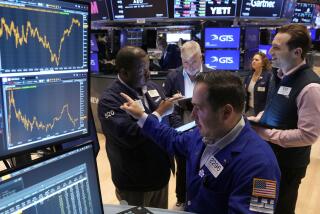There’s No Big Binge in Half a Point
Federal Reserve Chairman Alan Greenspan on Wednesday did exactly what he needed to do by dropping short-term interest rates another half-point, but it’s not enough.
The Great Economic Slowdown of 2001 (let’s not call it a recession quite yet) came on partly because Greenspan raised short-term interest rates too high, starting in June 1999 and continuing through five more rate increases.
Now he’s backtracking, and interest rates are going back below where they were when he started. That should give the economy a needed boost.
Not surprisingly, on word of the rate cut, the stock market reversed direction and scored one of its largest one-day rallies ever. But can the rally be sustained? And what’s the outlook beyond the immediate euphoria?
Notably, two-thirds of the recent economic slowdown has been because of a dramatic drop in capital spending. At the start of last year, American businesses were buying new equipment (much of it high-tech) at an annual rate 20% above the year before. By last December, the bottom had fallen out of capital spending.
Greenspan’s rate cut alone won’t convince businesses to start buying a lot of equipment any time soon.
Think of capital spending as one end of a long tube. At the other end are consumers. The purpose of buying a lot of high-tech equipment is to be more efficient in making things and providing services that, ultimately, consumers will buy.
But what happens if consumers can’t or won’t buy at nearly the rate necessary to justify all the capital spending? This is the heart of the current dilemma.
The dirtiest little secret about the Roaring ‘90s is that average working families gained almost no income. From 1986 through 1997 (the latest year for which detailed Internal Revenue Service data are available), the average income of the richest 1% of Americans rose 89% to $517,713. During these same years, the average income of the bottom 90% of Americans rose just 1.6% to $23,815. (These figures, not incidentally, are after all federal income taxes were paid.)
Rich people don’t spend nearly as much of their income as middle-income people do. Rich people tend to save more of their earnings. Average working people don’t have that option.
So it stands to reason that as most of the income gains of the 1990s went to the top, typical American consumers eventually hit the wall. They couldn’t spend more--at least not without going into debt, and there’s a limit to that.
Yet American businesses continued to invest in capital equipment as if consumers would remain on a consumption binge. As consumer debt mounted in the late 1990s, consumers couldn’t possibly keep up.
They’re still buying, to be sure. Yet the rate of increase in consumer spending isn’t coming close to justifying all that capital spending. The bottom had to fall out, and it did.
Greenspan’s rate cut was necessary but not sufficient. The core of the American economy is the nation’s large middle class and its capacity to spend.
These people have reached their limit, which means the surge in capital spending that marked the late 1990s is probably over for some time, Greenspan or not.
More to Read
Inside the business of entertainment
The Wide Shot brings you news, analysis and insights on everything from streaming wars to production — and what it all means for the future.
You may occasionally receive promotional content from the Los Angeles Times.









